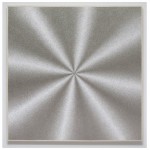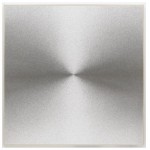Tara Donovan at Pace Gallery
A sort of antic incrementalism, in which the sheer number of accumulated found objects stuns the viewer into submission, clogging their visual arteries, presently constitutes an academy in itself. How do we know? Art schools and project rooms across the nation are filled to the brim with such compilations. And indeed it is hard to gainsay so much labor, so many hours of tedious assembling. And indeed some people are very, very good at it. (It’s interesting that so many practitioners of this style are women—as if having been the target of consumer campaigns for so long, women are now throwing it all back in the face of the public.) Tara Donovan’s past sculptures have likewise cherished an OCD mania, featuring a work ethic on amphetamines, combined with a Tom-Friedmanesque ingenuity with everyday objects. That was at once their allure and their drawback: a cloud of plastic cups—how clever! Donovan’s previous works were truly accomplished but perhaps a tad . . . mmmm . . . “gimmicky “ (sorry, swore never to use that word). Still, you had to admire how she worked and worked that schtick. And it WAS clever.
Well, forget all that now. With these new pieces Donovan has hit pay dirt. Transcendent rather than amusing, they at the same time subtly subvert all transcendental convictions. First of all, she has taken on the picture plane and all its optical splendors. Walking into the gallery you think you are seeing some beautifully rendered revisions of the classic, abstract white painting. Drenched in radiance and reverie—could they be Malevich’s “face of God”, blanched? Minimal in their presentation, maximal in the number of changes rung from work to work, they leave the viewer utterly unprepared for the surprise of finding, on close inspection, that all this light and shapely immanence comes from pins. Millions of them—all right maybe not millions. But so many, so precisely arranged to create perfect effects by virtue of number, placement and depth that the mind reels. The algorithmic vertigo makes one fervently hope there was digital assistance for the surely sore digits of the assistants. Donovan lures us into what should be the reassuring pleasures of the repetitive task but instead of comfort there is the abyss—the complexity of this process is literally dizzying. The viewer is bedazzled by effects whose formula cannot be readily or at any rate quickly calculated and that failure constitutes a loss of control in keeping with an ecstatic experience. The light bouncing off those pinheads—countless angels thereon or not—sets up the beatific rapture of seraphim. And yet . . . they are just pins, straight pins even, nothing tricky, nothing special in themselves. It’s a wonderful moment after the decades-long attempts to lower the barrier between art and craft. Wonderful because here we have blatant and proud handicraft merging seamlessly with the “great tradition,” with all things Greenbergian, with Russian suprematism, Ryman syncretism, Op Art, etcetera, etcetera, etcetera. Meanwhile the needle is gloriously lost in a needle haystack.
Bridey Schufli







